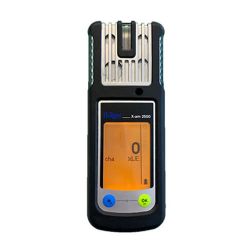Combustible gas detectors
A combustible gas detector measures the presence of explosive or flammable gases according to their LEL (Lower Explosive Limit). It is used for the detection of explosive combustible gas leaks such as natural gas, butane, propane, hydrocarbons, solvents or alcohols.
The response of the combustible gas detector is based on the reference gas from which the explosimeter is set (standard gas). Methane (CH4) or pentane (C5H12) are the most commonly used gases for the calibration of these devices.
-
-
-
-
X-am 5600 - 6 gas monitor Ex/CO2 (IR), Cl2, ClO2, CO, H2S, HCN, NH3, NO, NO2
Starting at €1,479.00Quickview -
OLCT100 fixed gas detector - ATEX SIL2 combustible, toxic & refrigerant gas
Starting at €775.00Quickview -
-
Infrared fixed gas detector for hydrocarbons or CO2 - Simtronics GD10P
Starting at €2,445.00Quickview
Combustible gas detection: the explosimeter
Catalytic diffusion sensors are the most used devices to monitor flammable and explosive gas or vapors. Without getting into too much detail, it is important to keep in mind the working principle of this measurement technology. The catalytic bead sensor is able to monitor combustible gas concentrations through the temperature elevation of a filament.
This temperature change is translated into a quantifiable indicator: the LEL (lower explosive limit). However there is one drawback: the sensor can monitor concentrations but can’t identify the different gases. It’s the same principle as a weighing scale: it gives the weight but doesn’t say who is on the scale.
Lower explosive limit (LEL)
The explosive capacity of a gas is defined by two limits. Between these two values conditions are set for explosion or fire to occur:
- The LEL (or Lower Explosive Limit): above this minimal concentration in the air, the gas can be inflamed.
- The UEL (or upper explosive limit) is the maximal volume concentration in the air below which it can explode or provoke fire ignition.
Below the LEL the gas mix concentration in the air is too low on combustible to ignite reaction. Above the UEL oxidant gas (usually oxygen) is lacking to provoke any reaction. A combustible gas detector always monitors concentrations between 0 and 100% of the LIE.
Combustible gas detector most commonly used LEL values
- Acetone 2,5 % vol.
- Acetylene 2,5 % vol.
- Ammonia 15,0 % vol.
- Benzene 1,2 % vol.
- Butane 1,9% vol.
- Ethanol 3,3 % vol.
- Hydrogen 4,0 % vol.
- Carbon monoxide 12,5 % vol.
- Methane 5,0 % vol.
- Methanol 6,0 % vol.
- Pentane 1,4 % vol.
- Propane 2,1 % vol.
- Styrene 0,9 % vol.
- Toluene 1,1 % vol.
- Xylene 1,1 % vol.



